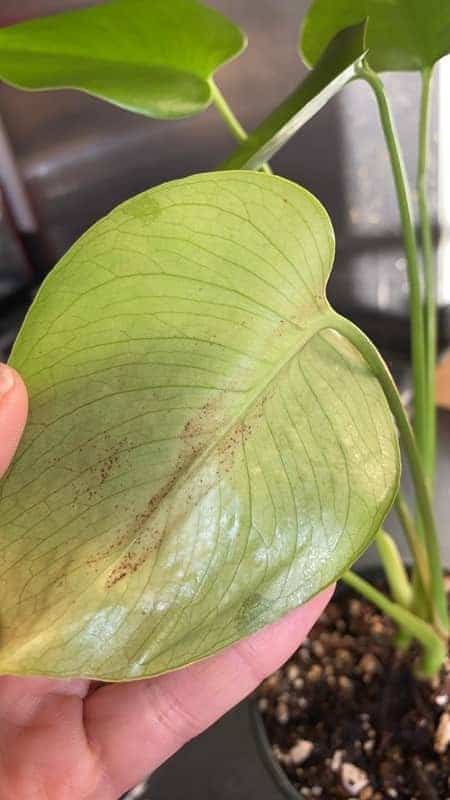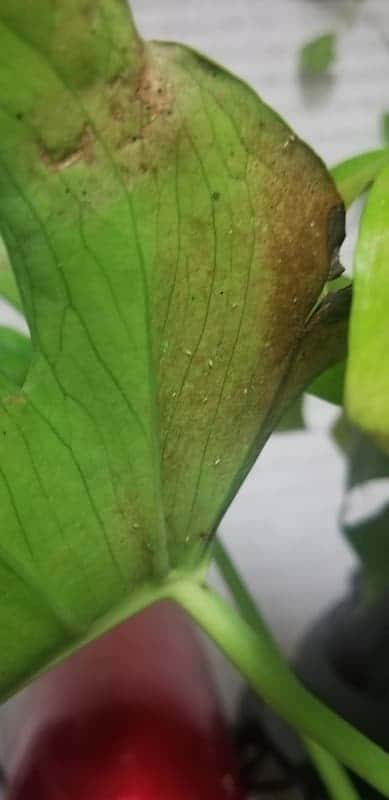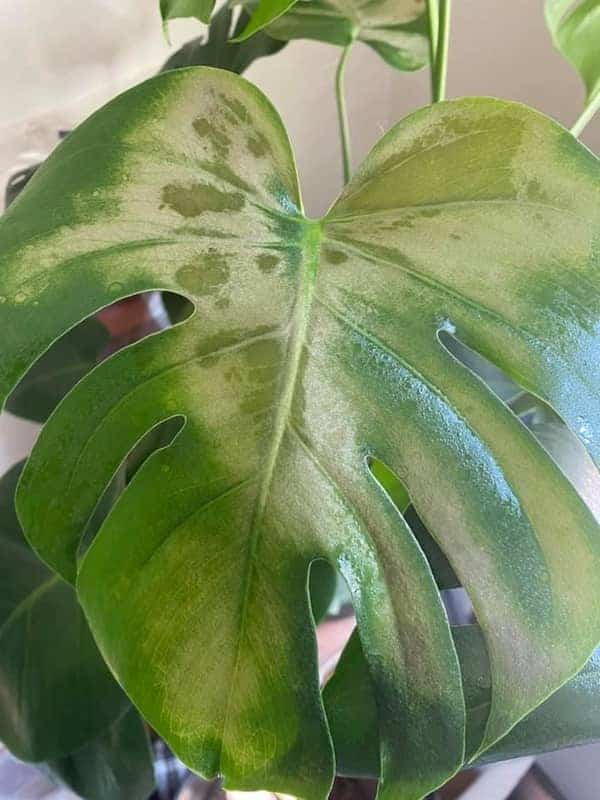Monstera is a stunning plant with large heart-shaped glossy foliage. However, these lovely leaves can be ruined by these unsightly, bothersome yellow spots at times. Yellow spots on foliage are a red flag if you’re a seasoned gardener!
Fungal diseases such as septoria leaf spot, monstera leaf blight, powdery mildew, rust, and anthracnose are the most common causes of yellow spots on monstera leaves. Apply fungicides to eliminate fungal spores. Keep the plant in a well-ventilated area and allow the soil to dry between waterings.
Put on your detective hat, because I’m going to assist you in determining what’s wrong with your Monstera.
Contents
- What Causes Yellow Spots on Monstera Leaves
- How to Prevent Yellow Spots on Monstera
What Causes Yellow Spots on Monstera Leaves
[1] Improper Watering
The most common abiotic cause of yellow spots on monstera leaves is a lack of water. Monstera leaves turn yellow or become speckled with yellow spots when exposed to too much or too little water.
They can also be a symptom of overly wet conditions, which cause fungal leaf spot diseases.
Improper watering and nutrient deficiencies frequently coexist. This is especially true for iron, magnesium, and nitrogen deficiencies. This is due to the fact that soil moisture affects your monstera’s ability to absorb nutrients.
I’ve put together a table to help you tell the difference between an overwatered monstera and an underwatered monstera.
| Overwatered Monstera Plant | Underwatered Monstera Plant |
| Wet or soggy soil. Appears darker and takes more than 10 days to dry out. | Bone-dry growing medium. Appears dusty and lighter. |
| Yellow or brown leaves with water-soaked browned edges | Foliage turning crispy and browning at the tips and edges. Leaves may also turn yellow. |
| Wilting monstera goes limp or droop | Wilting monstera looks dehydrated & dry |
| Black, swollen or rotting stems | Drooping, limp, or sagging stems |
| Leaves are soft or mushy when touched | Curling, wrinkled, or discolored leaves |
| Water-soaked raised dark brown spots on leaves. These spots are usually bordered by yellow concentric rings due to bacterial infection. | Dry brown spots on leaves. If unchecked, they will dry out and form dead areas. |
| The potting mix may give off an unpleasant rotting smell. You may see mold or mildew growth on the surface. | The soil surface appears crusted and doesn’t smell rotten. |
As you can see, most of these symptoms of too much and too little water are similar. So, if your monstera has yellow spots on leaves, the first thing to look for is a change in the growing medium. Insert your index finger into the ground.
- Is it wet all the way?
- Is it mushy or soggy?
- Is there a rotten smell emanating from the soil?
Underwatering your monstera is more problematic than overwatering it. Yellowing of older or lower foliage is the first symptom to appear. Root rot has most likely infiltrated the plant when it begins to wilt and develop yellow spots.
Crispy brown or yellow leaf tips and edges are the first signs of dehydration. New growths are also the first to fall victim to underwatering. The leaves will eventually wilt, die, and fall off.
Other watering issues that may cause yellow spots on monstera leaves include water splashing, wetting leaves, and overhead irrigation. The same is true for watering your monstera with tap water.
Solution
Fixing a thirsty monstera is easy:
- You must water it deeply and thoroughly
- Make sure to water your plant until excess liquid oozes out of bottom drain holes
- If it’s potted, you can let it soak moisture from the bottom in a bathtub or sink filled with water. Allow it to drain excess water completely before putting it back.
- To avoid underwatering, water every one to two weeks. Allow two inches of the growing medium to dry out between irrigations.
Reviving an overwatered monstera is a lot trickier. The best course of action will depend on whether there’s root rot and its severity. If monstera roots are still healthy, let the growing medium dry out and you should be set.
If root rot has encroached on your monstera, repotting your plant is a wise decision. Here’s how:
- First, prune out any dead, diseased, or heavily affected parts.
- Unpot your monstera and trim away rusty brown or black mushy roots. You should only be left with white bouncy roots on the root ball.
- Treat your monstera with fungicide before repotting with a new batch of growing medium. Mix in hydrogen peroxide for improved sanitation. I also add some perlite, coconut coir, or lava rocks to enhance aeration and drainage.
- Give proper growing conditions to facilitate recovery
Note: monstera is highly sensitive to salts or chemical deposits mostly found in city tap water. So, it would be best to use distilled or filtered water. Rainwater is another worthy alternative.
[2] Monstera Leaf Blight
Leaf blight is a fungal disease that affects monsteras in warm, moist environments. Typically, the fungal spore overwinters in fallen leaves or other debris. It usually infects your monstera through irrigation water.
Leaf blight is visible on foliage near the soil line.
This is especially noticeable if your monstera has been overwatered. The lower (older) foliage develops dark brown spots surrounded by yellow rings. As a result, the yellow spots on monstera leaves resemble target rings.
As the fungal disease progresses, the leaves will turn brown, curl, and die. The monstera plants that are the oldest and youngest are the most susceptible to leaf blight.
Control and Treatment
The key to controlling monstera leaf blight is to treat it as soon as possible. When you notice leaf blight on your monstera, spray it with a fungicide labeled for leaf blight.
I recommend grab-and-go sprays like mancozeb, Anilazine, or copper octanoate (Check the latest price of Amazon here).
Cultural changes can also come in handy:
- Don’t work or handle wet monsteras
- Sterilize your garden clothes and cutting tools
- Avoid overwatering, water splashing, and overhead irrigation
Remove, bag, and destroy infected parts, debris, and plant matter. Make sure to do so before. winter.
[3] Bacterial Leaf Spot
Bacterial leaf spots are most common on monsteras that are stressed or overwatered.
Any Xanthomonas or Pseudomonas bacteria can cause it. The disease can present itself in a number of ways.
Dark brown spots with yellow halos are the most common symptoms.
On the leaves, you may notice some dark or light dead spots. Spots with black edges appear in severe infections.
Bacterial leaf spots are frequently irregular in shape and can spread to half an inch in diameter.
They can register on the undersides as well as the tops of foliage. A sticky substance may ooze from these areas.
Yellow or brownish-yellow spots are most commonly found at the tips and edges of the tips. They can dry out and tear away leaf tissue.
The leaves become delicate and thin or papery as a result of this process. If the infection is severe enough, it will defoliate the entire plant.
Treatment
- Remove and isolate your monstera at first sight of bacterial leaf spot.
- Your best shot is prevention. And it all comes down to good sanitation. Remove and discard fallen foliage and plant debris
- The few treatment measures you can use will only work in the phase of the disease. These include the use of bactericides and copper fungicides.
[4] Anthracnose Disease On Monstera Leaves
If you’ve noticed a smattering of small brown, yellow, or tan spots on underside of the monstera leaves, you’ve got anthracnose. It is a fungal disease that affects monstera and other plants during the spring season.
The causative fungus Colletotrichum spp thrives in wet, cool conditions. So, it may also attack cold-damaged or overwatered monsteras.
Common symptoms include:
- Leaves become yellow along the margins
- The yellow edges turn tan then finally dark brown
- Young leaves will have brown spots surrounded by yellow shade
- Large lesions or cankers may appear on stems
Treatment
- The good news is that anthracnose is rarely fatal for monsteras. In any case, you should avoid wounding your monstera. This increases the entry points for the fungus.
- Hot and dry conditions help slow down the spread. So, you should avoid overwatering, misting, or wetting your Swiss Cheese plant.
- Increased aeration can also help. Isolate your monstera in an airy room with less humidity.
- Keep your monstera healthy to ward off the pathogen.
[5] Root and Stem Rot
Yellow spots on monstera leaves or general yellowing can indicate stem or root rot. Rotted stems are typically brown, swollen, and soft to the touch.
On the stem, you may also notice some brown necrotic spots. When your monstera suffers from stem rot, it is likely suffering from root rot below the soil line.
This is most common when your monstera has been overwatered, wet, or poorly lit in humid conditions for an extended period of time.
Affected roots are usually black or rusty brown in color and have a mushy, soft texture.
Extremely dry potting mix can also cause root damage. As a result, monstera roots are susceptible to the fungal disease root rot.
Control and Management
- Avoid watering, don’t wet the leaves, and use a well-draining growing medium to manage both root & stem rot.
- A consistent irrigation schedule is in order. Water your monstera when the top two or three inches of growing media is slightly dry. Dump out any excess water that has collected on the saucer.
- Repot your monstera if it has mild root rot or stem rot. Don’t forget to prune all affected leaves, stems, and roots. Treatment with a proper fungicide will deter reoccurrence.
[6] Powdery Mildew
Powdery mildew on monstera leaves typically begins as tiny white dusty spots that spread before covering the entire plant.
This gives the undersides of monstera leaves a light gray to white powdery or dusty appearance.
Powdery mildew-infested leaves, on the other hand, are unable to photosynthesize properly. As a result, your monstera will lose vigor and grow slowly. Yellow spots on the leaves are one of the symptoms.
Affected leaves also curl up, turn yellow, and die. Eventually, they’ll shed prematurely.
Treatment
- Prevention is one of the best ways to treat powdery mildew from affecting your monstera. Find a warm, bright spot for your monstera. Make sure the temperature hovers above 65°F (18°C) to deter powdery mildew.
- Space your indoor plants at least one foot apart. Also, prune your monstera to encourage air circulation
- Prune out any mildewed foliage at first sight
- Mix one part raw/skim milk and nine parts water then use to treat powdery mildew. You can also use baking soda, mouthwash, neem oil, or mild fungicides.
[7] Rust
Rust fungi cause rusty yellow, brown, or orange flecks on the foliage of Monstera plants.
They are most commonly found on the undersides of leaves, but they can also appear on the tops and stems of leaves.
Powdery spots or pustules may appear black or purplish-brown in some cases.
Treatment
- Prevention is the best treatment against rust on monstera
- Robust air circulation will help dry out and curb rust faster. So, prune out heavily-rusted foliage. Ensure proper aeration inside and around your monstera.
- Avoid overwatering, as rust proliferates in damp environments
- Treat your monstera with neem oil.
[8] Septoria Leaf Spot
Septoria on monstera initially appears as water-soaked spots on the undersides of older foliage.
The centers of these small watery spots are light tan or gray, with dark brown edges. You might also notice yellow haloes around them.
The fungal disease spreads upwards, blemishing younger, upper leaves with brown yellow-ringed spots.
Affected leaves may become overly stressed and unable to photosynthesize, resulting in death and drop.
Treatment
- Treatment starts with proper garden hygiene. Sterilize pruning instruments, never handle wet foliage, and clean up plant debris, especially before winter arrives.
- Treating your monstera includes using copper, ziram, or potassium bicarbonate fungicides. Apply on a 7-10 day spraying schedule as needed.
[9] Nutrient Deficiency
Your monstera leaves may develop yellow spots because of nutrient deficiencies.
You’ll likely see this if your monstera is lacking iron, pottasium, nitrogen, or a combination.
This usually happens if the growing medium has been depleted of nutrients. Or, due to insufficient lighting.
Nutrient deficiencies and water problems often go hand in hand, worsening the problem.
That’s because overwatering and underwatering affect your plant’s ability to take up nutrients from the soil.
Solution
- Repot your monstera afresh. This will ensure it has proper moisture and nutrient content in the growing medium.
- Ideally, you should repot a young monstera plant yearly in early spring until it’s fully mature. Make sure to go one pot size up each time you repot. A well-draining, nutrient-dense potting mix would be great.
- Add some peat moss or compost and equal part perlite to boost both fertility and drainage.
- Feed your monstera well-balanced liquid fertilizer regularly during the growing period between May and September.
[10] Bugs on Monstera Causing Yellow Spots
Common monstera bugs cause yellow spots to develop on the foliage. That’s because these pests munch away at specific areas on the leaves.
Some also drink sap out of your plant, leaving damage spots that may appear yellow, brown, or black.
The most common pests you’ll find on monstera include:
- Mealybugs: These small bugs appear as white fuzz or cotton-like clusters on the undersides of leaves. They’re sap-suckers that excrement honeydew. The yellow spots may appear under the black sooty mold that develops.
- Spider Mites: These bugs love hot & dry environments. They can appear themselves as yellow colonies. However, soft webbing on leaves and stems gives them away.
- Scale: Soft-scale insects often invade monstera plants. They appear as small raised bumps on foliage and stems. They can range in color from beige to brown. Symptoms include sooty mold due to honeydew, yellowing, and stunted growth.
- Aphids: Wooly aphids can be vectors for monstera leaf blight, causing yellow spots on foliage. The color of aphids on monstera can vary from yellow, brown, red, black, and white.
Control and Management
- Wash off most monstera pests using a strong blast of water. Dub some like mealybugs using alcohol-dipped cotton swabs.
- You can use natural predators like lady beetles, parasitic wasps, and lacewings
- Weekly application of insecticidal soap, neem oil, or insecticide spray can help eradicate most of them
[11] Improper Lighting/Sunburning
As with all plants, your monstera has chloroplasts that help produce the green-pigmented chlorophyll. That’s what helps monstera bless your home with lush greenery.
When it doesn’t receive enough light, there isn’t enough chlorophyll and thus your monstera leaves turn pale or yellowish.
Too much direct sunlight can also beam on certain areas of the foliage. This causes leaf tissue to die and leads to the same yellowing issue. Splashing the leaves can worsen the problem.
The water droplets will act as magnifying lenses. They’ll concentrate light on splashed areas. This causes your monstera leaves to be speckled with yellow spots.
Solution
- Move your monstera away from too much direct sunlight or dark rooms.
- Its placement should receive a good amount of bright, indirect sunlight
How to Prevent Yellow Spots on Monstera
- Ensure good airflow by pruning your monstera leaves and stems. Space your indoor plants at a minimum of 1 ft. between them.
- Adopt good watering practices – Allow 2-3 inches of potting mix to dry out before the next irrigation. Overhead irrigation, water splashing, and leaf wetting are a no-no.
- Practice good garden hygiene – Remove plant debris, sterilize pruning equipment, and don’t work your monstera when wet
- Ensure your monstera is healthy and free from pests and disease right from the store
- Provide proper light (bright, indirect), temperatures, and well-draining growing medium

















